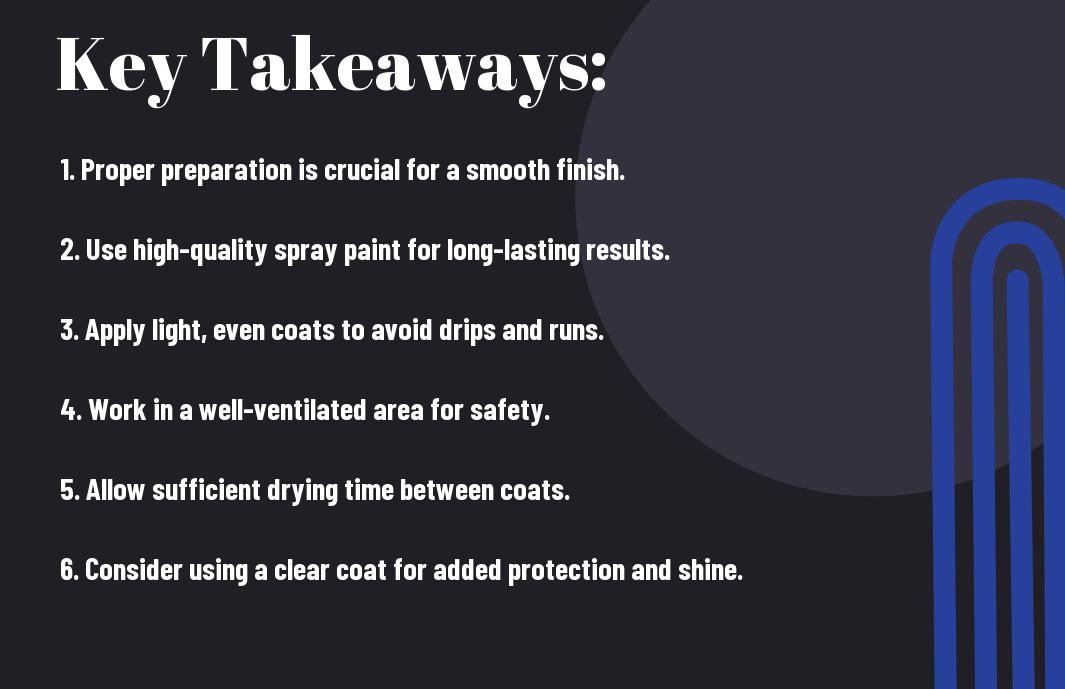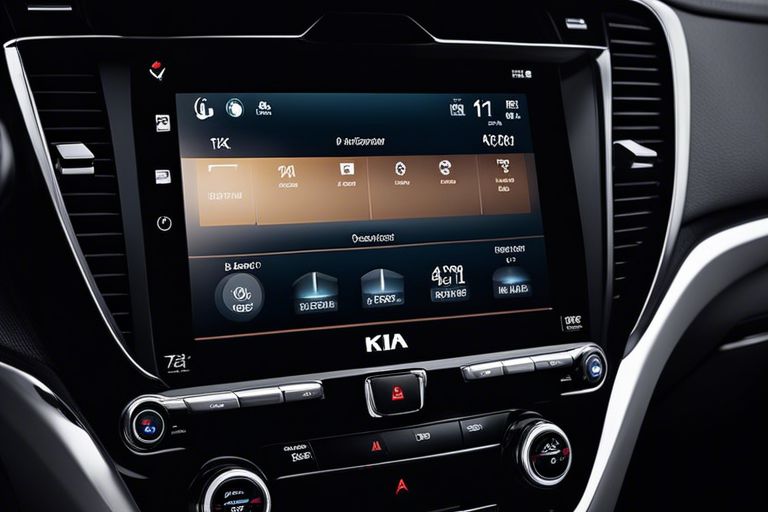Experienced car enthusiasts know that applying spray paint on a car can be a tricky process. It requires precision, patience, and the right technique to achieve a flawless finish. In this blog post, I will share with you the essential steps and tips for spray painting your car like a pro. Whether you’re looking to touch up small scratches or give your car a whole new look, mastering the art of spray painting is crucial for any car owner. I will guide you through the preparation process, painting technique, and finishing touches to ensure that you achieve stunning results without causing any damage to your vehicle. Let’s dive in and learn how to spray paint your car the right way!
Key Takeaways:
- Prepare the Surface: Properly clean and smooth out the surface of the car before applying spray paint to ensure a flawless finish.
- Choose the Right Paint: Select a high-quality automotive spray paint that matches the color of your car for a professional-looking result.
- Use Proper Technique: Apply thin, even coats of paint using a back-and-forth motion to avoid drips and ensure a smooth, consistent coverage.
- Allow for Proper Drying Time: Be patient and allow each coat of paint to dry completely before applying the next one to avoid smudging or uneven application.
- Protect the Paint Job: After the paint has dried, apply a clear coat or wax to protect the new paint and give your car a glossy finish.

Preparing the Car for Spray Painting
To achieve a professional-looking finish when spray painting a car, it’s crucial to properly prepare the surface before applying the paint. In this chapter, I will guide you through the important steps to take in order to ensure a successful spray painting process.
Cleaning and Sanding the Surface
To start, thoroughly clean the surface of the car to remove any dirt, oil, or old paint. This can be done using a grease-cutting soap and water, followed by a final wipe down with a wax and grease remover. Once the surface is clean and dry, it’s essential to sand it to create a smooth and even base for the paint to adhere to. Use a fine-grit sandpaper to gently sand the entire surface, paying particular attention to any rough or uneven areas. This step is crucial for ensuring proper adhesion of the new paint and achieving a professional-looking finish.
Masking off Areas to Avoid Overspray
Before beginning the spray painting process, it’s important to carefully mask off any areas of the car that you want to avoid getting paint on. This includes windows, trim, and any other areas that you want to keep free of paint. Use painter’s tape and masking paper to cover these areas, ensuring that they are fully protected from overspray. Additionally, it’s important to use a drop cloth or plastic sheeting to protect the surrounding area from overspray as well. By meticulously masking off these areas, you’ll be able to achieve a clean and professional finish without any unintentional paint coverage.
Choosing the Right Spray Paint and Equipment
Some car enthusiasts might underestimate the importance of using the right spray paint and equipment when it comes to working on their cars. But trust me, using the right materials and tools can make a significant difference in the final result. When it comes to choosing the right spray paint and equipment, there are a few things to consider. First, you want to make sure you are using the correct type of paint for your car. For more information on this topic, check out How to use spray on touch up paint – Maintenance/Repairs.
Selecting the Proper Paint Type
When selecting the proper paint type for your car, it’s essential to consider factors such as the color match, the quality of the paint, and the specific type of paint needed for your car’s make and model. Whether you are touching up a small scratch or repainting a large area, using the wrong type of paint can result in a less-than-desirable finish. Remember to always choose the type of paint that is recommended for your car to ensure a seamless and durable finish.
Using the Correct Tools and Techniques
Equally important to choosing the right paint is using the correct tools and techniques for the job. This includes using the appropriate spray gun, ensuring proper ventilation, and taking necessary safety precautions. Remember, using the wrong tools or techniques can not only result in a poor paint job, but it can also be dangerous. Always make sure you are using the proper tools and techniques to achieve the best results.
Applying the Spray Paint
Now that you have prepared the surface of your car and chosen the right spray paint, it’s time to start applying the paint. This is a crucial step in achieving a professional-looking finish, so it’s important to take your time and follow the proper techniques.
Applying Thin, Even Coats
When applying spray paint to your car, it’s crucial to apply thin, even coats. Thick coats can lead to drips, runs, and an uneven finish. I recommend holding the can about 6-8 inches away from the surface and using a steady, back-and-forth motion to apply the paint. This will help to ensure an even application and prevent any buildup of paint in one area. Remember, several thin coats are better than one thick coat, so take your time and build up the color gradually.
Allowing Sufficient Drying Time Between Coats
Another important factor in achieving a professional-looking finish is allowing sufficient drying time between coats. I cannot stress this enough: do not rush the drying process. Applying additional coats of paint before the previous coat has fully dried can lead to a range of issues, including cracking, bubbling, and an uneven finish. I recommend following the manufacturer’s instructions for drying times and, if in doubt, allowing a little extra time to ensure each coat is completely dry before proceeding.
Final Touches and Care
Your fresh new spray paint job is complete, but there are a few final touches and care tips to keep in mind to ensure your car’s new look lasts for as long as possible.
Removing the Masking Tape and Cleanup
Once the paint is dry, carefully remove the masking tape from the areas you covered during the painting process. Be gentle to avoid accidentally peeling off any freshly painted surfaces. Use a clean cloth and some mild solvent to remove any overspray or paint residue from the surrounding areas. Take your time with this step to make sure your finish is clean and polished.
Proper Care and Maintenance of the Painted Surface
Now that your car is looking fresh and vibrant with its new paint job, it’s important to take proper care of the painted surface to maintain its appearance. Regular washing and waxing can help protect the paint and keep it looking great for years to come. Avoid using harsh abrasives or cleaners as these can damage the paint and clear coat. Strong chemicals, such as gasoline, should also be avoided as they can eat away at the paint and cause irreparable damage. Regular inspection and touch-up of any chips or scratches can help prevent rust and keep your car looking its best.

Conclusion: Spray Paint on a Car – How to Do It Right?
Considering all points, it is crucial to ensure that you are well-prepared before attempting to spray paint your car. This includes selecting the right tools and materials, properly preparing the car surface, and applying the paint in a controlled and even manner. It is also important to take the necessary safety precautions and to practice proper techniques to achieve the best results. By following these steps, you can successfully spray paint your car and achieve a professional-looking finish. Remember, take your time, follow the proper process, and don’t rush the job. With the right approach, patience, and attention to detail, you can transform the look of your car with a fresh coat of spray paint.
FAQ
Q: Is it possible to use spray paint on a car?
A: Yes, it is possible to use spray paint to touch up and customize your car’s surface. However, it requires careful preparation and meticulous application to achieve professional-looking results.
Q: What is the best type of spray paint to use on a car?
A: Automotive acrylic lacquer is the best type of spray paint to use on a car. It provides a glossy, durable finish and is designed to withstand the wear and tear of the road.
Q: How should I prepare my car for spray painting?
A: Proper preparation is crucial for successful spray painting. This includes thoroughly cleaning and degreasing the surface, sanding down any imperfections, and using masking tape to protect areas that should not be painted.
Q: What are some tips for achieving a professional finish when spray painting a car?
A: It’s important to apply thin, even coats of paint, and to allow each layer to dry completely before applying the next. Additionally, working in a well-ventilated area and using a respirator mask can help ensure a smooth, polished finish.
Q: Are there any safety precautions I should take when spray painting a car?
A: Yes, it’s important to wear protective gear such as gloves, goggles, and a respirator mask to protect yourself from harmful fumes and chemicals. Additionally, it’s essential to work in a well-ventilated area and follow all safety recommendations provided by the spray paint manufacturer.








Leave a comment